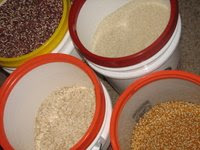 Now that you can easily determine how much food you need the next question is how to store it. There are several different approaches to storing food but the ultimate goal is to eliminate the threat of oxygen, which breeds insects, moisture, heat, and rodents. The methods below should be used for all grains, legumes, and powdered milk. However, pasta that is purchased in sealed plastic bags do not need to be treated but it is a good idea to seal them in buckets to prevent rodents from getting into them.
Now that you can easily determine how much food you need the next question is how to store it. There are several different approaches to storing food but the ultimate goal is to eliminate the threat of oxygen, which breeds insects, moisture, heat, and rodents. The methods below should be used for all grains, legumes, and powdered milk. However, pasta that is purchased in sealed plastic bags do not need to be treated but it is a good idea to seal them in buckets to prevent rodents from getting into them.The easiest way to store food is to buy it prepackaged in buckets from the grocery store, warehouse stores, or granaries. This is also the most expensive, however, it is easy to prepare your own buckets. Food can be stored in any PETE, or food grade, plastic. DO NOT store food in milk jugs! They will break down over time and contaminate your food. I prefer to store my food in a five gallon bucket with an airtight lid. They can be purchased at many grocery stores or emergency preparedness stores such as Emergency Essentials. I've seen the price range from $2.99, at Macey's grocery store, up to $8 so I watch the weekly circulars and buy them in bulk when they go on sale. A friend told me that you can find them for free at your local grocery store bakery. They usually have them left over from frosting. If you do this you will still need to purchase a new lid to assure that it is airtight.
The next step is to treat the bucket with dry ice. This is the method I use. It is very simple and my kids have fun with any extra dry ice. The presence of carbon dioxide in concentrations above 3% is adequate to kill weevil. 1) Use approximately 1 oz. of dry ice/gallon. 2) Wipe frost from dry ice with a clean towel. 3) Place the dry ice in the center of the container bottom. 4) Pour food on top and fill container within 1/2" to 1" of the top. 5) Snap lid only about half way around the container to allow gas to escape. 6) Check to see in the dry ice is evaporated by feeling the bottom of the container. If it is still cold the dry ice is still present. 7) Seal the lid but monitor the container for a few minutes. If it bulges lift the lid slightly to relieve pressure. The lid may pull down slightly over time. This is normal.
Another effective way to store food is in #10 cans. The LDS cannery is a great place to pack your own food. At the cannery you will place an oxygen absorber in the top of the can before it is sealed to protect the food from weevil. Please note that oxygen absorbers are not effective in plastic containers.
After you have packaged your food in your desired container it is important to date it and then store it in a well ventilated, clean, dark, dry, and cool location. Do not store your food on or against cement or dirt floors. Place pieces of wood between the floor and the container to provide ventilation and to protect from moisture. This is especially important when using #10 cans as they will rust.
I hope this is not an overload of information. Next time I will address the storage requirements of other food storage items as well as what not to store. Good luck!



Dear Abby,
ReplyDeleteI used oxygen absorbers in all my big plastic buckets. Do you know why they don't work? I hate to have to reopen and dry ice them all. What should I do?
Nicole
Hi Sheri. I love your new blog. Hope all is well with your sweet little family.
ReplyDeleteTake Care,
Ali